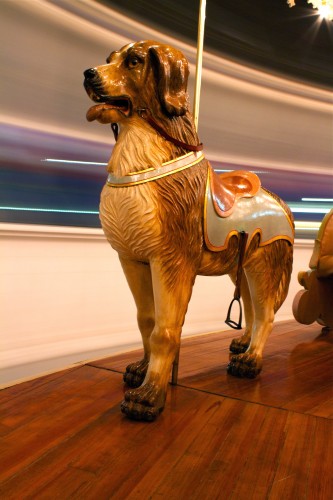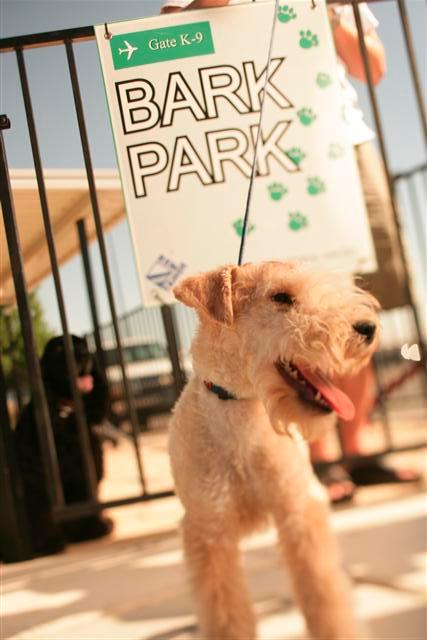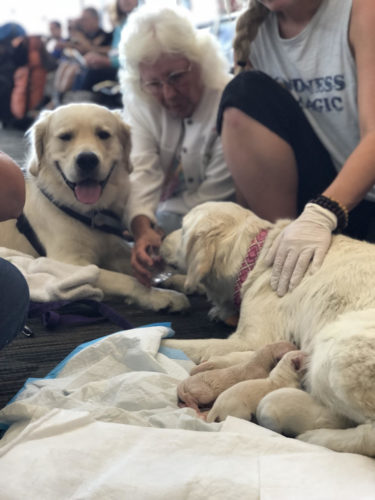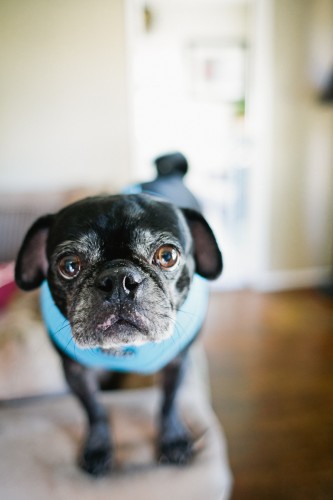
Thinking of taking dog your pet or emotional support animal with you on your next flight? Be sure to check the airline -and the airport – rule books on that. As I describe in my ‘At the Airport’ column this month for USA TODAY, airports are following the lead of airlines and making new and more restricted rules for animals in the terminals. Below is a slightly edited version of that column.

There were plenty of “Aw, that’s so cute” social media posts last month when Eleanor Rigby, one of two service dog vest-wearing golden retrievers accompanying a passenger to Philadelphia on American Airlines, went into labor and gave birth to eight puppies in a gate area at Tampa International Airport.

(Courtesy TPA Airport)
No one was charmed, however, by the report a passenger at Los Angeles International Airport posted last February about a woman who replied “They have people for that” when asked if she planned to clean up after her dog did its ‘business’ on the airport floor.
Yet both stories are examples of a wide range of animal-related incidents that are forcing airports to expend extra resources and causing them to rethink policies governing animals in the terminals.
In the Tampa airport puppy case, cute became controversy when animal rights advocates and people with certified service animals began questioning if the vested dogs were legitimate service animals and asking why a very pregnant dog – be it a certified service animal, emotional support animal or pet – had been allowed to fly so close to its due date.
TPA officials point out that airports have no say over the animals that airlines allow on board.
“We were just there to help with the situation and are happy the puppies were delivered safely,” said TPA spokeswoman Emily Nipps.
Tampa International Airport hasn’t yet tallied up its exact costs for having paramedics, operations, communications and maintenance staff spend several hours attending to Eleanor Rigby and her new puppies during the airport delivery, “But having paramedics assisting a dog in labor could have potentially impacted a medical emergency on another side of the airport,” said Nipps.
Cleaning up: the rules and the messes
As had been widely reported, airlines have seen a sharp rise in the number of animals traveling on planes. Some are ticketed pets, but many are pets that have been flying for free thanks to loopholes in rules governing the transport of emotional or psychiatric support animals.
American Airlines reported a 40% increase in the number of service and emotional support animals on flights between 2016 and 2017. United Airlines cited a 75% increase year over year.
Like airlines, airports have had to make accommodations for all the extra animals and, like airlines, airports have been logging increased instances of pets and emotional support animals that are untrained, unruly and dangerous to others in the terminals.
“We find them making messes on the airport carpet, interfering with the airport’s working dogs and, on occasion, biting other dogs or passengers,” said Kama Simonds, spokeswoman for Portland International Airport.
Last December, a 5-year old girl ended up in the hospital after being bit in the face by an uncrated dog waiting for a flight with its owner at Portland International Airport. And a local TV station filming for a report on dog issues at PDX caught a schnauzer in the act of peeing on the airport’s brand new $13 million carpet.
Many airports hope revised policies for flying with emotional support animals recently rolled out by American Airlines, Alaska Airlines, Delta, JetBlue, United and others will cut down on the number of animals in airport terminals.
“The way we see it, if the airlines put more specific and stricter guidelines in place to manage the issue, it will take care of the problem in the airport too,” said TPA’s Emily Nipps, “So we support the airlines in tightening up the policies.”
For its part, Airports Council International-North America, the membership organization which represents and advises most U.S. airports, is urging the Department of Transportation to clarify its rules.
Currently, there’s confusion for both passengers and airports because airlines are covered by the Air Carrier Access Act, which recognizes emotional support animals, while airports are covered by a different act, the Americans with Disabilities Act, which does not recognize emotional support animals.
“We want DOT to clearly articulate that airports are within their rights under the Americans with Disabilities Act to require anyone bringing an emotional support animal through an airport terminal to house those animals in carriers, so they don’t interfere with other passengers, employees, staff or other animals including service animals and TSA and police canine units,” said Thomas Devine, ACI-NA’s general counsel.
DOT is currently taking comments through July 9 on proposed rulemaking related to traveling by air with service animals and ACI-NA will join the public and other industry groups in filing comments.
But at least one airport is not waiting for DOT to get around to making its final ruling.
After consulting with other airports, including San Francisco International, Detroit Metropolitan and Fairbanks International Airport, Portland International Airport plans to issue new rules aimed at clearly defining the different categories of traveling animals—pets, emotional support animals and service animals—and clarifying how the airport expects travelers to care for these animals while in the terminal.
“We see many people bring their pets when meeting and greeting people in the terminal. That’s a no-no,” said PDX spokesperson Kama Simonds, “Pets should not be at the airport unless they are traveling or being shipped.”
The new PDX rules will remind travelers that, like pets, the airport requires emotional support animals heading for airplanes to be in carriers while in the terminal. If too large for a carrier, those emotional support animals must be kept on short leashes.
And if a traveler’s animal urinates or defecates on the floor at PDX, the new rules will require an owner to remain at the site until someone from the janitorial staff arrives.
During July, airport operations staff at PDX will start spreading the word about the new rules. Come August, though, warnings and citations for bad dogs could be issued, with possible fines of up to $250.
